What Was The Services For Baking In 1600
The history of breadstuff in France and its food culture is looked upon with envy across the globe. If you bake breadstuff yourself, you've probably made a French-inspired loaf at to the lowest degree once. French classics such as baguette, brioche and pain au levain (sourdough) are recognised across the globe. Fifty-fifty pop staff of life like the Pullman loaf is heavily influenced (if not stolen) from the original hurting de mie.
High-quality artisan bread is common in France, you lot'll detect a boulangerie on every high street. But how did it get similar this, and, how has breadstuff civilization been preserved?
Why is bread so important in French republic?
Bread is a staple food eaten across the world every 24-hour interval by all ages and social classes. Like cooking and winemaking, France wrote the rule book for baking bread. France is considered the cultural home of quality staff of life, much like Italy is the habitation of pizza. French people relied on bread for centuries as their main food source. They proceed to support the artists who perfect the skill of making beautiful bread. A loftier-quality bread is always respected for being great, not rejected equally it is expensive.
On Jan 13, 2018, it was reported that French President, Emmanuel Macron supported calls for the baguette to be recognised by the United nations as a "cultural treasure". He claimed that it "is the envy of the world". The baguette, alongside all French bread, is interlocked with many important events in national history.

Hey in that location! Some links on this folio are affiliate links which means that, if you choose to make a purchase, I may earn a modest commission at no extra cost to you. I profoundly capeesh your support and I hope y'all savour the article!
History of French blistering
But how did this come to exist? Whilst nearly of us enjoy a fresh, tasty baguette, how many of us know the history of the bread itself in French republic? Also how information technology has been developed across the years? That is what this article will attempt to cover… So let'due south observe out!
Aboriginal discoveries- When bread first originated
Breadstuff does not come from France. Grinding stones dated xxx,000 years old have been unearthed in Australia and Europe. Their likely use would be for grinding wheat to make breadstuff, just there is no supportive prove of this. Using modern dating technology we can estimate that staff of life was eaten between 14,600 and 11,600 years ago.

The primeval conclusive prove of staff of life making is at the archaeological site of Shubayqa 1 in the Black Desert, Jordan. Charred flatbread crumbs made from wheat, barley and plant roots were discovered here. Alongside quern stones were constitute with starch traces. Quern stones are ancient grinding stones, similar to a pestle and mortar which accept been constitute beyond the globe that date to Neolithic times.
The vii Things Yous're (Probably) Doing Incorrect!
Improve Your Baking Skills With My Free Electronic mail Course- Sign Up Here!
A prehistoric homo would have made a 'flatbread' by cooking a paste of h2o and flour on stones. It is a far cry from French bread that we observe today. Simply it would have made a welcome change to their existing diet which would have mainly consisted of meat.
Arab republic of egypt- The discovery of sourdough
The offset examples of 'modernistic bread' were found in Mesopotamia and Egypt. This is staff of life where a leaven was used. Leavened bread was first made around 4,600 years ago.
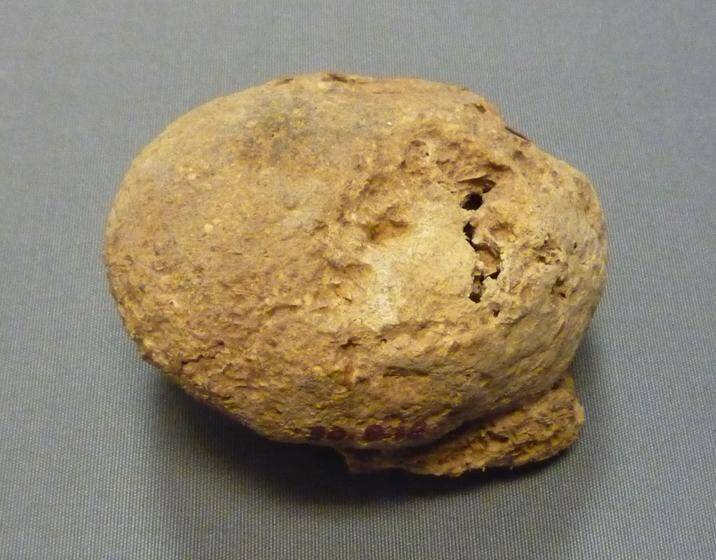
A baker from Ancient Egypt (probably) forgot to dry out the flatbread dough and left information technology on a warm stone. The warm weather condition led to the mixture fermenting and rise. After it was cooked, the fermented mixture produced a nicer taste and tender texture.
The first version of sourdough had arrived! The Egyptians mixed their sourdough levain with ground wheat and left information technology to expand. The dough would then be broiled on the fire.
The Romans – How breadstuff evolved in French republic
Bread making became an of import part of European society. Wheat could be grown with ease across the continent. Information technology was 1 of the first farmed foods in existence. By growing and harvesting wheat en mass, people could be fed and goods could be traded. It's argued by some that the economy of the world is built on wheat.
At the fourth dimension of the Roman invasion of France, staff of life was milled by hand and baked in homes and villages beyond French republic and the remainder of Europe. When the Romans invented h2o-milling in around 450 BC, the ability to supply flour increased! Wheat became a very important commodity.
Heart ages
Information technology's the Heart Ages where bread developed within the lives of European people. Breadstuff became the primary source of food for all kinds of life. In French republic, the standard "boule-shaped" loaf became challenged by more elaborate designs. It's around this time that France began shaping its reputation for extravagance. Information technology also became a world leader in baking and cooking techniques.
Several bread recipes were fabricated for the kickoff time here, often for special occasions. Cakes, bread and pastries were produced by adept bakers for the Monarchy. Though in the lower classes, bread making took place at abode. Those without an oven would go to a nearby bakery with their dough. They would pay a minor fee for it to be baked, putting a unique mark on the loaf as they handed it over to the baker then they knew which 1 was theirs.
French bread in 1700s
Bread was fully embedded in French culture. Though diets had moved on with the importation of saccharide and other exotic foods, bread was still at the forefront of French diets. Wheat accounted for sixty-fourscore percent of the bulk of French household budgets. Bread was not but a nutrient, it was a driving force for life and it fabricated its mark in French political history.
The French revolution
The colour of staff of life eaten started to signify a persons social class. Darker coloured bread indicated the eater was lower class, while whiter bread displayed a higher class. This was at a time when the population of French republic had risen severely and a series of poor harvests lead to a shortage in wheat. Sadly, King Louis XVI continued to ignore the need for wheat. The cost rose dramatically and the poor began to starve.
The lower classes, tired of nobles with fine white breadstuff and living in luxury became angry. Fifty-fifty when poorer residents could get bread, it was inappreciably worth eating as the grain was so poor.
The lack of quality bread and "The Age of Enlightenment" led to a national revolution. The National Assembly would win and the death of the monarchy (and King Louis) occurred in 1793. Later on, a fix of regulations were made to eliminate social inequality. A translation of the legislation regarding bread is shown beneath.
"Richness and poverty must both disappear from the authorities of equality. Information technology will no longer make a staff of life of wheat for the rich and a staff of life of bran for the poor. All bakers volition be held, under the penalization of imprisonment, to make only i blazon of bread: The Bread of Equality."
Another of the key reforms was to standardise the price of bread sold. After the breadstuff of equality act was enacted, bakeries sprung upwardly in towns and villages across France. The residents of France began buying more than bread instead of making it themselves.
How bread grew in popularity in France
Specialist bakers became popular, and French republic started to go famous for its speciality bread. Skills and recipes would be shared with excellent levels of training for new bakers. France started to forge some of the world's best bakers, turning French republic into the uppercase of Bread.
The roller factory
In 1834, the start steel roller manufacturing plant was invented in Switzerland. Information technology speedily revolutionised bread baking in many countries, including France. Instead of crushing the grain, a roller system breaks it open up. This means the germ, bran and endosperm can be easily separated.
The introduction of the steam oven
Bread was baked in a dry oven which produces staff of life with soft crusts and inconsistent textures. Afterward diverse experiments, in the late 1800'south the steam oven was introduced in France.
Steam baking creates a boiling surround where the setting of the crust is delayed. Bread fabricated in a steam oven was soft in the crumb and well-baked on the crust.
How breadstuff was fabricated in French republic
Most staff of life till the mid-belatedly 19th century was levained with sourdough or pâte fermentée. The pâte fermentée method works by retaining 30-50% of a batch of dough. Information technology is then added to the adjacent batch the post-obit twenty-four hour period. The procedure is repeated daily. Eventually, the levain develops flavor and naturally occurring yeasts. It'due south a great manner of leavening bread and is notwithstanding used in many top bakeries across the globe.
View my beginners sourdough bread recipe
Equally bakers yeast was introduced to bakeries in French republic, it sped up product. But this was detrimental to the flavour and texture of the bread. To combat this, French bakers adopted a preferment technique from Polish bakers who had settled in French republic.
A portion of flour from a bread recipe is soaked with the aforementioned weight of water and a small amount of yeast. The mixture is lightly stirred, covered and left overnight. During this period the yeast ferments the flour making it a powerful levain. Once added to the dough, information technology improves the doughs maturity and then the bulk fermentation, or kickoff rise flow can be reduced.
They chosen this method a "Poolish" and is similar to a Biga, a method used in Italy.
It's these changes that help us to understand what makes French staff of life taste French.
When politics and bread changed history again!
Information technology was (and nonetheless is) pop for bread to be eaten for breakfast in France. Staff of life makers would work overnight for their breadstuff to exist fix to display in the morning.
Later the 2nd world state of war, in a mode to protect their workers from overworking a regulation was issued by the government. It stated that bread makers were not allowed to start piece of work before 4 am.
This posed a challenge for breadstuff makers at that time. Getting the outset batch of breadstuff baked in time for breakfast became a challenging chore.
A new symbol of bread history
To overcome the new legislation, artisan bread makers came up with an innovative idea. Instead of making the large loaves that were previously popular, bakers made thinner and smaller loaves.
This new bread was an adaptation of the Fiscelle, but smaller. A diameter of no more than 2 inches fabricated production much faster. Bakers could beginning work at 4am and fix bread in time for breakfast. This bread was called the Baguette.
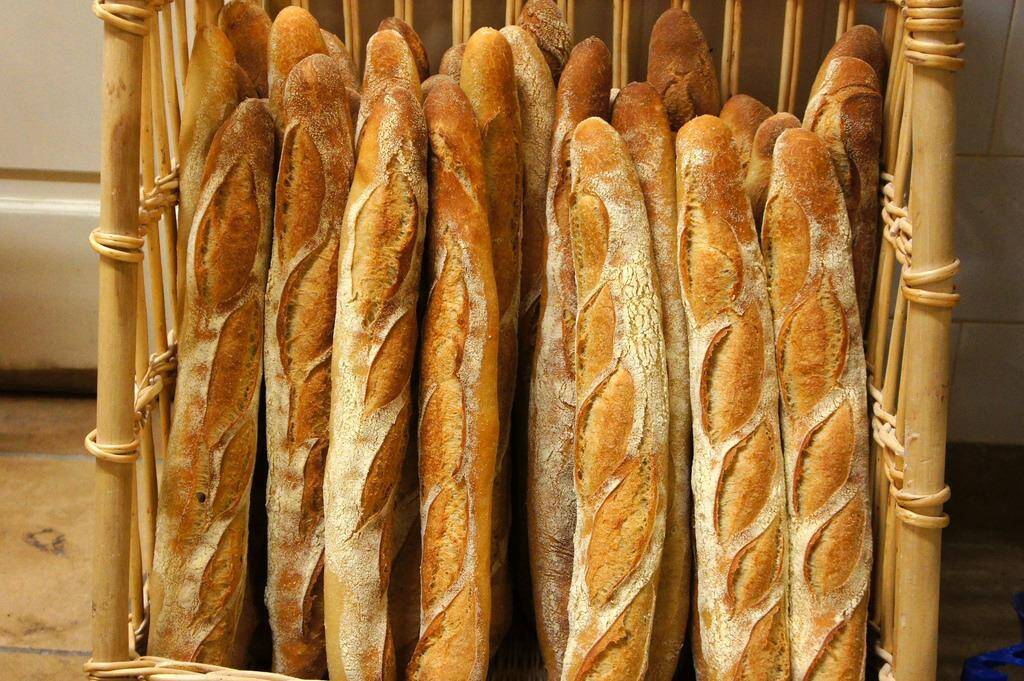
Today, every hr of every solar day, it is common to see French people carrying a baguette, tucked nether their artillery. It accompanies meals, makes sandwiches or is just eaten on its own as a snack. Here is my accurate french baguette recipe with poolish if you'd like to make them yourself.
Bread makers are happy to innovate with baguette sizes, simply the industry standard is 50cm long. Baguettes are one of the attractions that tourists come to encounter and sense of taste in France.
Characteristics of Baguettes
Apart from their unique shape, baguettes are very hard on the outside but soft on the inside. The baguette always has a golden crisp crust on the outside.
If you want to know if a baguette is of good quality, printing it in your paw. If it returns to its original shape, it is proficient. If it doesn't, it's regarded poor.
It's regarded as the hardest bread to make by many artisan bakers. It involves several techniques to create perfection. In 1993, Decret Pain inaugurated the stick of bread as traditional French food.
An authentic baguette uses a couche for proofing. This keeps the shape of the baguette and allows them to be transferred to the stone of the oven for blistering. Click the link for the couche that I recommend.

Further reading: The history of the baguette explained.
Other types of bread in France
Besides Baguette, France has many other types of well-known staff of life such as Boule, Ficelle, and Brioche. There is little historical evidence for when each style was introduced. Here is the information that I tin find:

Boule
1 of the oldest bread from France is Boule. In French, boule means ball, and this is the shape the original staff of life makers would make dough. Round similar a ball.
A Boule in France has a texture like to a baguette. Crispy on the outside, but soft and chewy inside with a golden chaff on top.
Boule also includes large bread which can counterbalance upward to 500 gr to 1 kg.
Initially, bakers were more accustomed to making boules than baguettes. This is why bread makers in France are called "boulangers" and bakeries are chosen "boulangeries."

Ficelle
There is as well Ficelle, the original baguette. This bread is longer and thinner than a traditional baguette. In that location is no historical record of the exact origin of this bread.
However, historian Jim Chevallier believes the baguette starting time appeared during the eighteenth century.
Some sources say that the origins of the Baguette in France stem from Napoleon. He is rumoured to be involved in its creation before invading Russian federation. Demanding that bakers larn to broil bread that could fit in specially designed pockets on soldiers' uniforms.
The baguette or the longer, "ficellee" as it was chosen back in the early 1800's became less popular as the century went on.
Ficelle originally had a bland or mild gustatory modality. Now artisans making Ficelle add table salt or poppy and sesame seeds. Ficelle is oft served as a snack.
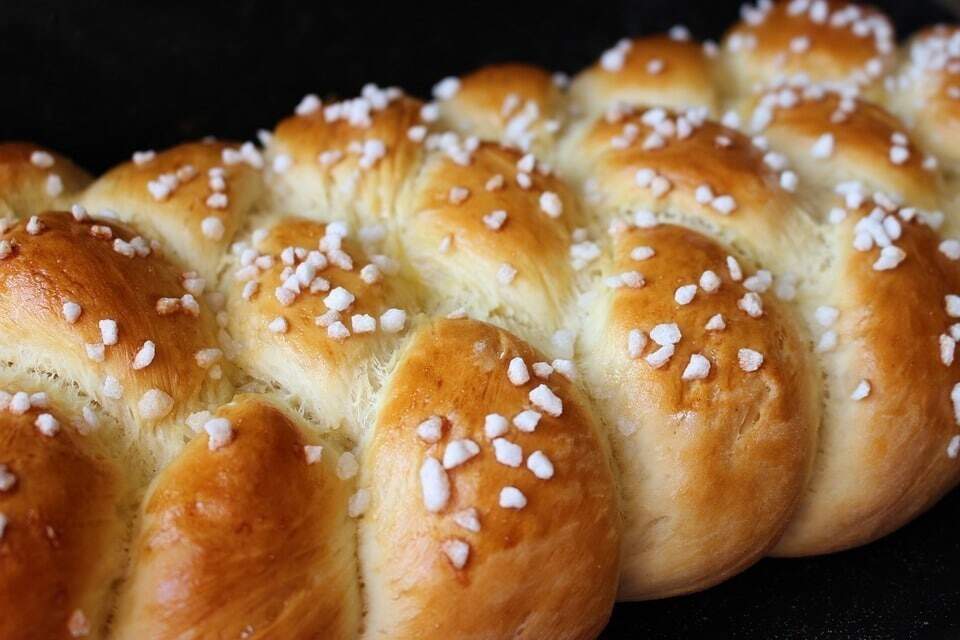
Brioche
Lots of inspirational forms of bread were born in French republic. Even though French people did not beginning invent many of them. According to some sources, Brioche was brought over by Norman people when they settled in French republic.
In the 800'south they produced a clandestine recipe for making butter and decided to include it in bread dough. This is when Brioche is believed to be offset created.
But it wasn't until 1404 that the first instance of Brioche has been found in print.
You would think someone tasting that amazing bread dorsum in the 800's would have written the recipe down? Merely hey, I'm no adept!
The proper name Brioche consists of the terms "bris" which means squeezing and "hocher" which means stirring. Unlike other French bread, Brioche is made with butter, eggs and sugar. Considering of this, brioche can exist eaten as a snack or a dessert. In the 16th century, information technology was often served at church where the pastor would anoint it and share information technology with his congregation.
Simply in the 18th century, France faced an economic crunch that made this bread very expensive.
Brioche became a symbol of one'southward wealth as the contents of butter within their brioche would be proportional to their wealth.
In fighting hunger, a story says that Queen Marie-Antoinette, the wife of Louis Xvi, advised in 1783, "Due south'ils n'ont plus de hurting, qu'ils mangent de la brioche." In English, it means "if they do not accept breadstuff, then let them eat the block." People believe that the cake that Queen Marie-Antoinette is referring to is Brioche. This event relates to the beginning of the stop of the monarchy in France. Brioche is categorised as viennoiserie which means 'things of Vienna'.
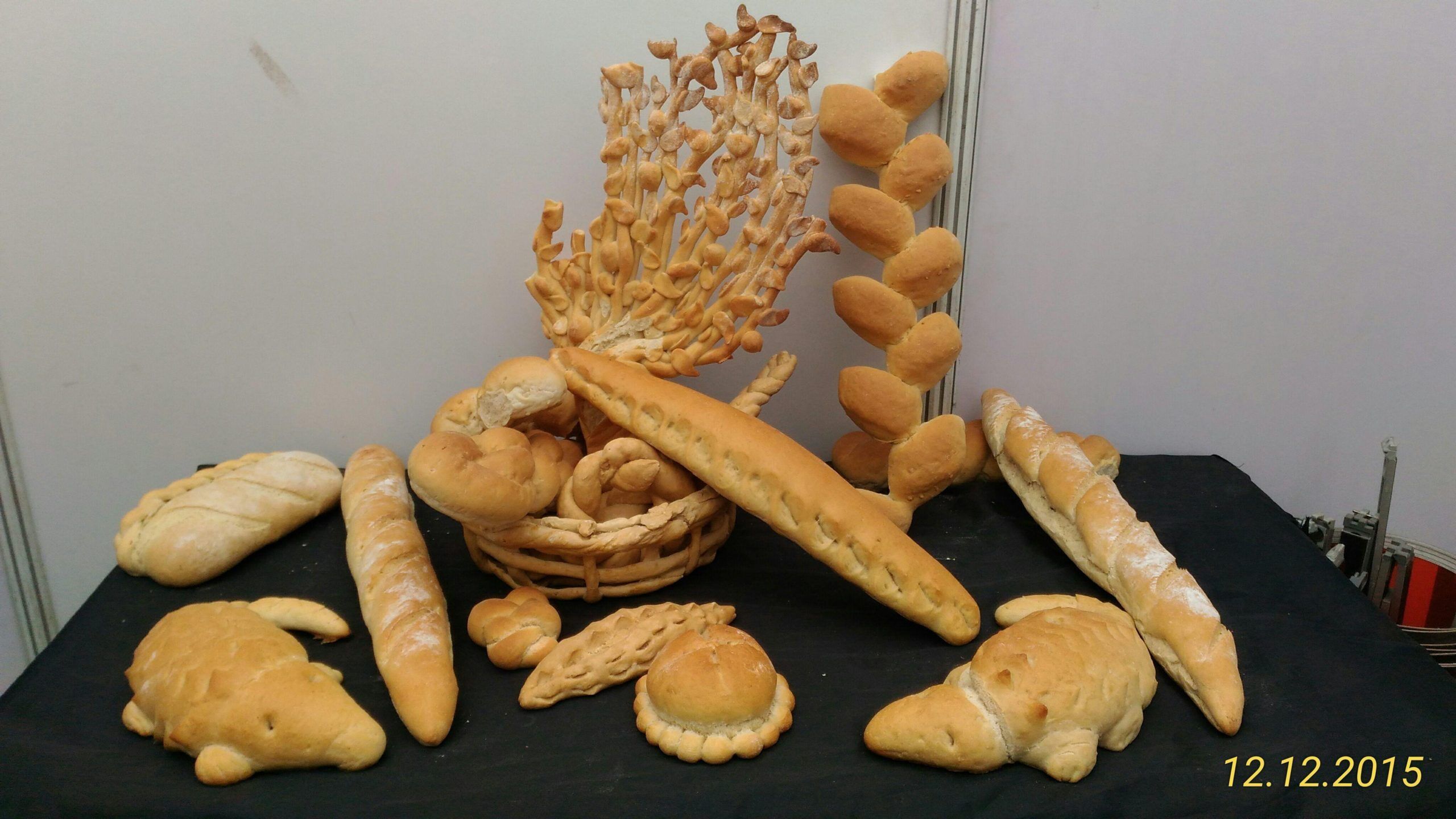
The real history of the croissant
Another famous breadstuff in France that is not actually from France is the croissant. According to many sources, the first example of this crescent-shaped pastry was in Austria.
Viennese people take what they call the Kipferl, which is believed to exist the ancestor of the croissant. Kipferl which means "crescent" has been found since the 13th century.
During that time, Vienna was surrounded by the Ottoman army. Vienna won the battle every bit bakers who were preparing the ovens to bake heard strange noises beneath their anxiety.
The bakers immediately reported the sounds. Gunpowder was found in tunnels where the Ottoman army had planned to blow up Vienna's walls. The authorities were able to intercept the tunnels while the Rex of Poland charged at the Ottomans who fled the scene.
They won the war, and later on that, a crescent-shaped bread based on the symbol of the Ottoman flag was created.
In the 18th century, it became famous in France thanks to Queen Marie Antoinette. The queen loved to accept kipferl for breakfast and was fundamental in its popularity among French people.
A French bread maker named Sylvain Claudius Goy made a crescent pastry in 1915 with the same technique. In 1920, croissants were officially declared as a traditional French product, even though they are non really French!
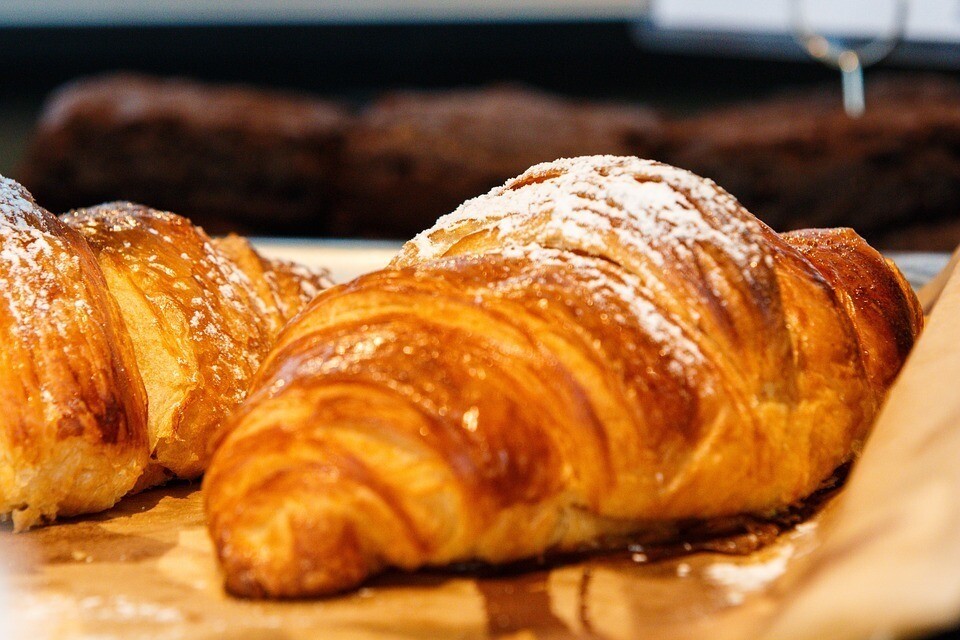
Modern staff of life practise in France
Is the price of bread still governed in France?
In 1978 the French government ended its control on the price of bread. It is now monitored closely by consumer associations that take kept the cost of staff of life low since. A baguette cost around 0.45 Euros in supermarkets to 0.90 Euros in bakeries.
The Bread Prescript (1993)
In 1993, the staff of life Decree, often referred to equally the French Bread Police force was instated. It governed the ingredients that can be used in bread dough. Information technology states which additives can be used and how much of them are allowed. The regulations are in place so that French bread can retain its famous characteristics.
Staff of life is still a part of French life
There are still a lot of bakeries in France. Co-ordinate to French Today, the current adding of bakeries is 1:1600 of the population. Bread is however very popular with French people as a staple for breakfast, dejeuner, and dinner. The history of bread in France lives on through today'southward culture.

Some bakers take their ain speciality bread recipes, while some follow traditional recipes. If y'all visit, you must determine which one is your favourite! Do you prefer traditional baguettes or special baguettes from the bakers?!
Staff of life is even so very much live in French communities and I suspect information technology will be a large function of their time to come too!
Ofttimes Asked Questions nigh French bread history
Why is bread so of import to French culture?
French bakers created bread and pastries to partner celebrations as early as the Middle Ages. At this time, bread was the staple food in France, as it was across the earth. The average Frenchman in the late 1700s is reported to eat three pounds of breadstuff a day! Information technology was largely made a home, with professional bakeries (boulangeries) springing upwardly later on the French revolution in 1793.
Why is a baguette called a baguette?
Because that's its shape. Baguette itself in English ways wand or stick. Baguette size is besides very various, from the smallest to the largest which can reach eight feet or 2.5 meters.
If you are in French republic, on every street corner, you will likely discover a bakery. Each store or boulangerie will take breadstuff with a similar form, long and thin like a stick, chosen a Baguette. It is a large part of the modernistic history of breadstuff in France, and the nowadays.
What Was The Services For Baking In 1600,
Source: https://www.busbysbakery.com/the-history-of-bread-in-france/
Posted by: humphreybuis1976.blogspot.com


0 Response to "What Was The Services For Baking In 1600"
Post a Comment